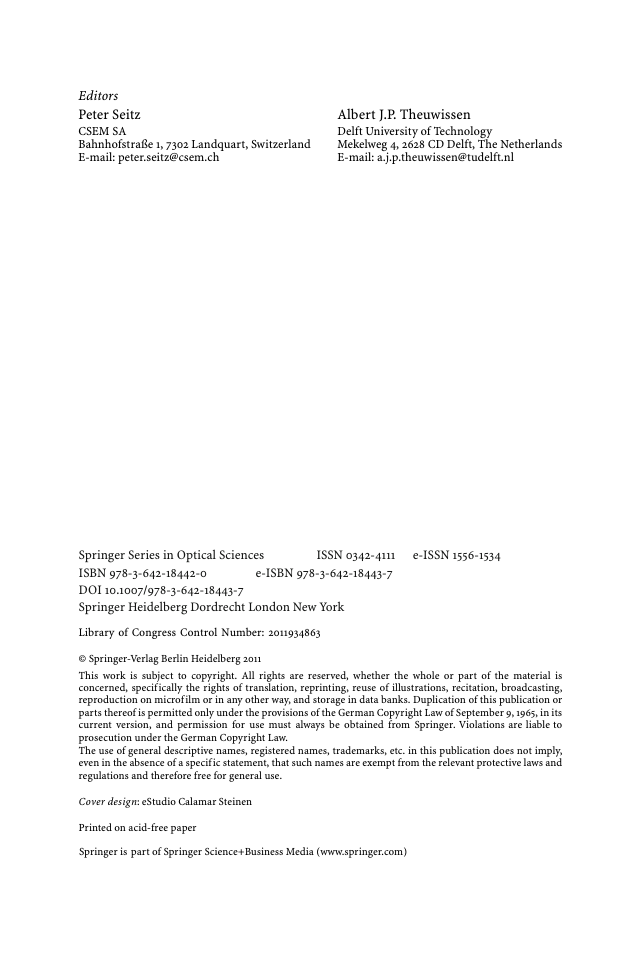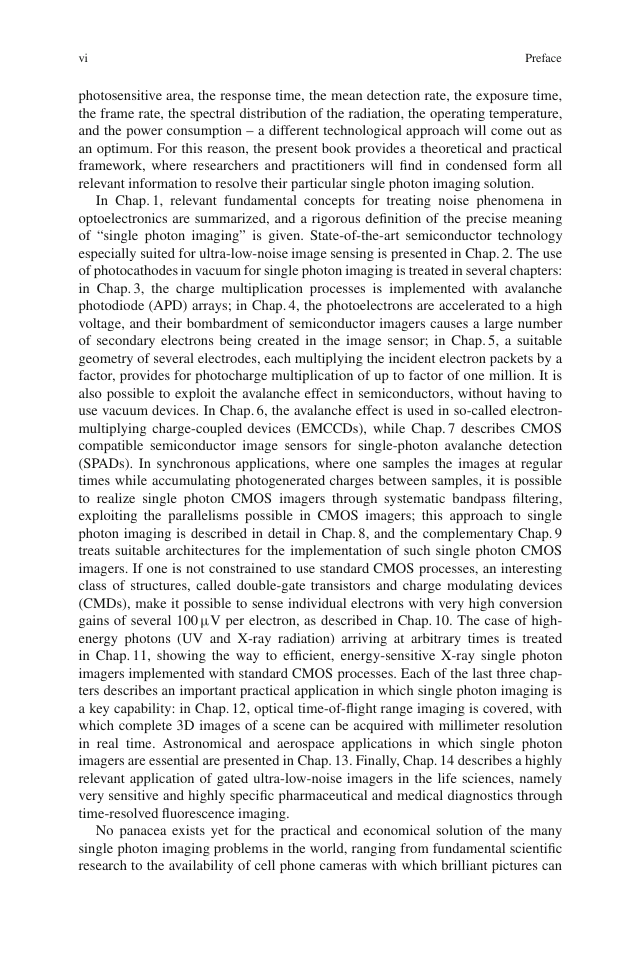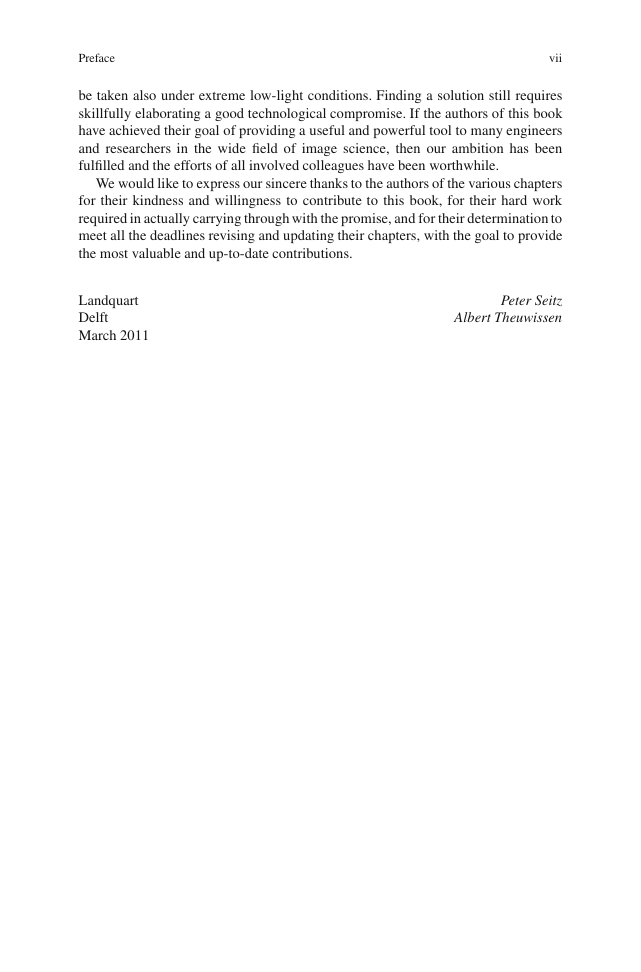Front matter
Single-Photon Imaging
Preface
Contents
Contributors
Chapter 1: Fundamentals of Noise in Optoelectronics
1.1 Introduction
1.2 Quantization of Electromagnetic Radiation, Electrical Charge, and Energy Statesin Bound Systems
1.3 Basic Properties of the Poisson Distribution
1.4 Interaction of Radiation and Matter
1.5 Noise Properties of Light Sources
1.5.1 Coherent Light (Single-Mode Lasers)
1.5.2 Thermal (Incandescent) Light Sources
1.5.3 Partially Coherent Light (Discharge Lamps)
1.5.4 Light Emitting Diodes
1.6 The Meaning of ``Single-Photon Imaging''
1.7 Energy Band Model of Solid State Matter
1.8 Detection of Electromagnetic Radiation with Semiconductors
1.8.1 Quantum Efficiency and Band Structure
1.8.2 Thermal Equilibrium and Nonequilibrium Carrier Concentrations
1.8.3 Dark Current
1.8.4 Avalanche Effect and Excess Noise Factor
1.9 Electronic Detection of Charge
1.9.1 Basic Components of Electronicsand their Noise Properties
1.9.2 Basic Circuits for Electronic Charge Detection
1.9.3 Conclusions for Single-Electron Charge Detection
1.10 Summary: Physical Limits of the Detection of Light
1.10.1 Sensitive Wavelength Range
1.10.2 Dark Current and Quantum Efficiency
1.10.3 Electronic Charge Detection
References
Chapter 2: Image Sensor Technology
2.1 Program and a Brief History of Solid-State Image Sensors
2.2 Anatomy of an Image Sensor
2.3 Operation
2.4 Image Sensor Devices
2.5 Image Sensor Process Technology
2.6 Outlook for a Single Photon Process Technology
References
Chapter 3: Hybrid Avalanche Photodiode Array Imaging
3.1 Introduction
3.2 Principle of Hybrid APD Operation
3.3 Single-pixel Large Format Hybrid APD
3.3.1 Device Description
3.3.2 Performance
3.3.3 Application
3.4 Multipixel Hybrid APD Array
3.4.1 Device Description
3.4.2 Performance
3.4.3 Application
3.5 Conclusions and Remaining Issues
References
Chapter 4: Electron Bombarded Semiconductor Image Sensors
4.1 Introduction
4.2 Electron Bombarded Semiconductor Gain Process
4.3 Hybrid Photomultiplier EBS Image Sensors
4.3.1 Hybrid Photomultiplier Gain and Noise Analysis
4.3.2 Hybrid Photomultiplier Time Response
4.3.3 Hybrid Photomultiplier Imagers
4.4 EBCCD and EBCMOS EBS Image Sensors
References
Chapter 5: Single-Photon Imaging Using Electron Multiplication in Vacuum
5.1 Introduction
5.2 The Photocathode
5.2.1 The Working Principle of Photocathodes
5.2.2 Multialkali Photocathodes
5.2.3 III–V Photocathodes
5.3 Image Intensifiers
5.3.1 Working Principle
5.3.2 Applications
5.3.3 The Components of an Image Intensifier
5.3.3.1 Input Window and Photocathode
5.3.3.2 Multichannel Plate
5.3.3.3 Phosphor Screen and Output Window
5.3.3.4 Enclosure and Power Supply
5.3.4 Performance Characteristics
5.3.4.1 High Light Level Performance
5.3.4.2 Low Light Level Performance
5.3.4.3 Image Artifacts
5.3.4.4 Comparison with Solid State Imagers
5.3.5 Special Image Intensifiers
5.3.5.1 Fast Gating Image Intensifiers
5.3.5.2 High Gain Intensifiers
5.3.5.3 Image Intensifiers with Electronic Output
5.3.5.4 Open MCP Detectors
5.4 Photomultiplier Tube
5.4.1 Working Principle
5.4.2 Applications
5.4.3 The Components of a PMT
5.4.3.1 Tube and Photocathode
5.4.3.2 Dynodes and Anode and Power Supply
5.4.3.3 Special PMTs
5.4.4 Performance Characteristics
5.4.4.1 Quantum Efficiency and Dark Current
5.4.4.2 Gain and Dynamic Range
5.4.4.3 Timing Characteristics
5.4.4.4 Comparison with Solid-State Detectors
5.5 Conclusions and Outlook
References
Chapter 6: Electron-Multiplying Charge Coupled Devices – EMCCDs
6.1 Introduction
6.2 Harnessing Impact Ionisation for Ultra SensitiveCCD Imaging
6.3 The Electron Multiplying CCD Concept
6.3.1 Output Amplifier Noise
6.3.2 The Use of Multiplication Gain
6.3.3 Noise and Signal-to-Noise Ratio
6.3.4 Output Signal Distributions
6.4 Photon Counting with the EMCCD
6.5 Background Signal Generation
6.5.1 Dark Signal
6.5.2 Statistics of Dark Signal Generation
6.5.3 Spurious Charge Generation
6.6 Improving the Efficiency of Signal Generation
6.7 Concluding Comments
References
Chapter 7: Monolithic Single-Photon Avalanche Diodes: SPADs
7.1 A Brief Historical Perspective
7.2 Fundamental Mechanisms
7.2.1 SPAD Structure and Operation
7.2.2 Idle State and Avalanche Buildup
7.2.3 Quench, Spread, and Recharge
7.2.4 Example Waveforms
7.2.5 Pulse-Shaping
7.2.6 Uncorrelated Noise: Dark Counts
7.2.7 Correlated Noise: Afterpulsing and Other Time Uncertainties
7.2.7.1 Afterpulsing
7.2.7.2 Optical and Electrical Crosstalk
7.2.7.3 Charge Pile-Up
7.2.8 Sensitivity: Photon Detection Probability
7.2.9 Wavelength Discrimination
7.3 Fabricating Monolithic SPADs
7.3.1 Vertical Versus Planar SPADs
7.3.2 Implementation in Planar Processes
7.3.2.1 Premature Edge Breakdown
7.3.2.2 Quenching and Recharge Implementation
7.3.3 SPAD Nonidealities
7.3.4 SPAD Array Nonidealities
7.4 Architecting SPAD Arrays
7.4.1 Basic Architectures
7.4.2 On-Chip Architecture
7.4.3 In-Column Architecture
7.4.4 In-Pixel Architecture
7.5 Trends in Monolithic Array Designs
7.6 Conclusions
References
Chapter 8: Single Photon CMOS Imaging Through Noise Minimization
8.1 Introduction
8.2 Theory
8.2.1 QE and MTF
8.2.2 Photo-carrier Detection Probability
8.2.3 Additive Temporal Noise Systems
8.2.4 Uncorrelated Temporal Noise Sources
8.2.4.1 Thermal and Shot Noise
8.2.4.2 Flicker and Random Telegraph Signal Noise
8.2.4.3 Charge Transfer Noise
8.2.4.4 Capacitive Reset Noise
8.2.5 Correlated Temporal Noise Sources
8.3 Amplification and Bandwidth Control
8.3.1 Amplification
8.3.2 Bandwidth Control
8.4 Architectures
8.4.1 4T Pixel with Pinned Photodiode Column Level Amplification and CDS
8.4.2 4T CTIA Pixel with Pinned Photo Diode Column Level Amplification and CDS
8.4.3 Architecture Comparison
8.5 Low-Noise CMOS Image Sensor Optimization
8.5.1 Electrical
8.5.2 Optical
8.6 Conclusion
References
Chapter 9: Architectures for Low-noise CMOS Electronic Imaging
9.1 Introduction
9.2 Signal Readout Architectures
9.3 Correlated Samplings and their Noise Responses
9.3.1 Correlated Double Sampling and Correlated Multiple Sampling
9.3.2 Response of CDS and CMS to Thermaland 1/f Noises
9.3.2.1 Modeling of CDS
9.3.2.2 Response of CDS to Thermal and 1/f Noises
9.3.2.3 Response of CMS Circuit to Thermal and 1/f Noises
9.4 Noise in Active-pixel CMOS Image Sensors Using Column CMS Circuits
9.5 Possibility of Single Photon Detection
9.5.1 Single Photon Detection Using Quantization
9.5.2 Condition for Single Photon Detection
References
Chapter 10: Low-Noise Electronic Imaging with Double-Gate FETs and Charge-Modulation Devices
10.1 Introduction
10.2 Double-Gate FET Charge Detector
10.2.1 Floating Well Type
10.2.1.1 Device Structure
10.2.1.2 Device Simulation
10.2.1.3 Evaluation
10.2.2 Floating Surface Type
10.2.2.1 Device Structure
10.2.2.2 Device Simulation
10.2.2.3 Evaluation
10.2.2.4 Discussion
10.3 CCD Image Sensor with Double-Gate FET Charge Detector
10.3.1 Sensor Construction
10.3.2 Feedback Charge Detector
10.3.3 Evaluation
10.3.4 Signal Processing
10.4 Charge-Modulation Image Pixel Application
10.4.1 Pixel Construction
10.4.2 Operation
10.4.3 Simulation
10.4.4 Results
10.4.5 Applications of Area Sensor
10.5 Conclusions
References
Chapter 11: Energy-Sensitive Single-Photon X-ray and Particle Imaging
11.1 Introduction
11.1.1 Applications
11.1.2 Basic Topology
11.2 Particle Sensing Devices
11.2.1 Direct Conversion Sensing Devices
11.2.1.1 Monolithic Detectors
11.2.1.2 Hybrid Detectors
11.2.2 Scintillators Coupled to Sensing Devices for Visible Light
11.2.2.1 p–n Photodiodes
11.2.2.2 Photogates
11.2.2.3 Buried Photodiodes
11.3 Asynchronous Charge Pulse Detecting Circuits
11.3.1 Charge Sensitive Amplifier
11.3.1.1 Feedback Resistor Noise of CSAs
11.3.1.2 Amplifier Noise of CSAs
11.3.1.3 Sensing Device Leakage Current Poisson Noise in CSAs
11.3.1.4 Sensing Device DC Current Compensation
11.3.2 Charge Sensitive Amplifier with Shaper
11.3.2.1 Feedback Resistor Noise of CSA-Shaper Circuits
11.3.2.2 Amplifier Noise of CSA-Shaper Circuits
11.3.2.3 Feedback Resistor Implementations
11.3.3 Voltage Buffer with Shaper
11.3.3.1 Noise Analysis of Buffer-Shaper Circuits
11.4 Voltage Pulse Processing Circuits
11.4.1 Energy Discrimination Methods
11.4.1.1 Multiple Threshold Discrimination
11.4.1.2 Amplitude Detection
11.4.1.3 Time-Over-Threshold Detection
11.4.2 Information Readout
11.4.2.1 Synchronous Readout
11.4.2.2 Self-Triggered Readout
References
Chapter 12: Single-Photon Detectors for Time-of-Flight Range Imaging
12.1 Introduction
12.2 Time-of-Flight Measuring Techniques and Systems
12.2.1 Time-of-flight System
12.2.2 Direct and Indirect Time Measuring Techniques
12.2.3 Optical Power Budget
12.2.4 D-TOF and I-TOF Noise Considerations
12.3 Single-Photon Sensors for 3D-TOF Imaging
12.3.1 Single-photon Detectors
12.3.2 Pixel Architectures for Single-photon TOF Imaging
12.3.3 Circuit Implementations for I-TOF Pixels
12.3.4 Circuit Implementations for D-TOF Pixels
12.3.5 State-of-the-art Time-resolved CMOS SPAD Pixel-array
12.4 Challenges and Future Perspectives
12.5 Conclusions
References
Chapter 13: Single-Photon Imaging for Astronomyand Aerospace Applications
13.1 Introduction
13.2 Scientific Detectors in Astronomy and Space Applications
13.2.1 Scientific CCDs
13.2.1.1 Hybrid Detectors for Infrared
13.3 Imaging Through the Atmosphere
13.4 Lucky Imaging Technique
13.5 Adaptive Optics
13.5.1 Principles
13.5.2 Wavefront Sensor Requirements and Detector Implementations
13.5.3 Infrared Detectors for Wavefront Sensor
13.6 Space LIDAR Applications
13.7 Concluding Remarks
Appendix
Visual Magnitude [71]
Astronomical Spectral Bands Denomination [71]
References
Chapter 14: Exploiting Molecular Biology by Time-Resolved Fluorescence Imaging
14.1 Introduction: Time-Resolved Fluorescence as a Uniquely Sensitive Detection Method for the Analysis of Molecular Biology
14.1.1 Labeling of Specific Molecules by a Long-Lifetime Fluorophore
14.1.2 Integration of the Investigated Specimens in a Planar Array: Homogeneous and Heterogeneous Assays
14.1.3 Excitation of Multiple Specimens in the Array by Intense Light Pulses and Imaging of the Arrayed Specimens on an Image Sensor conceived for Time-Gated Readout of the Fluorescence Signal
14.1.4 Microarray Assays
14.2 Properties of the Ideal Fluorophore for Ultra-Sensitive Fluorescence Detection
14.3 Ruthenium Complexes
14.4 Applications in the Life Sciences
14.4.1 Assay for Drug Discovery
14.4.2 Assay for Point of Care Testing
14.5 Prospective Use of Ultra-Low-Noise CMOS Image Sensors for Time-Resolved Fluorescence Imaging
References
Index
















 2023年江西萍乡中考道德与法治真题及答案.doc
2023年江西萍乡中考道德与法治真题及答案.doc 2012年重庆南川中考生物真题及答案.doc
2012年重庆南川中考生物真题及答案.doc 2013年江西师范大学地理学综合及文艺理论基础考研真题.doc
2013年江西师范大学地理学综合及文艺理论基础考研真题.doc 2020年四川甘孜小升初语文真题及答案I卷.doc
2020年四川甘孜小升初语文真题及答案I卷.doc 2020年注册岩土工程师专业基础考试真题及答案.doc
2020年注册岩土工程师专业基础考试真题及答案.doc 2023-2024学年福建省厦门市九年级上学期数学月考试题及答案.doc
2023-2024学年福建省厦门市九年级上学期数学月考试题及答案.doc 2021-2022学年辽宁省沈阳市大东区九年级上学期语文期末试题及答案.doc
2021-2022学年辽宁省沈阳市大东区九年级上学期语文期末试题及答案.doc 2022-2023学年北京东城区初三第一学期物理期末试卷及答案.doc
2022-2023学年北京东城区初三第一学期物理期末试卷及答案.doc 2018上半年江西教师资格初中地理学科知识与教学能力真题及答案.doc
2018上半年江西教师资格初中地理学科知识与教学能力真题及答案.doc 2012年河北国家公务员申论考试真题及答案-省级.doc
2012年河北国家公务员申论考试真题及答案-省级.doc 2020-2021学年江苏省扬州市江都区邵樊片九年级上学期数学第一次质量检测试题及答案.doc
2020-2021学年江苏省扬州市江都区邵樊片九年级上学期数学第一次质量检测试题及答案.doc 2022下半年黑龙江教师资格证中学综合素质真题及答案.doc
2022下半年黑龙江教师资格证中学综合素质真题及答案.doc